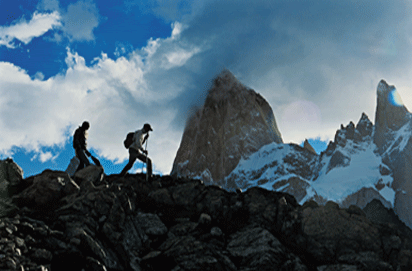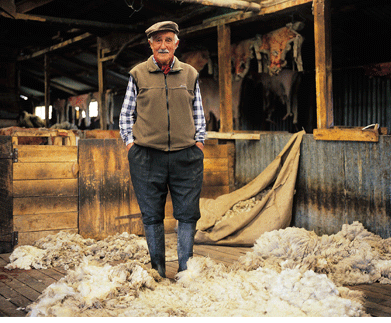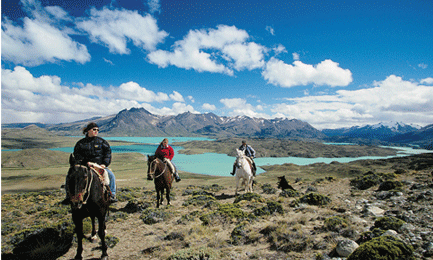
 Patagonia
Patagonia
On Top of the World
We live in paradise, and we will always have that.
By: Rick Ridgeway*
Photos: Peter McBride
“Choique?” my wife, Jennifer, asks.
“The Indian name for rheas,” I tell her. “See, over there, like small ostriches. Two of them.”
“Watch where you’re going!” she warns as our small pickup truck -- with our three teenagers, Carissa, Cameron and Connor shoehorned in back -- unexpectedly drifts onto the road’s shoulder. I stop and grab my binoculars.
“They’ve got babies,” I exclaim. “Six, maybe seven of them.”
We’re on the first day of our monthlong drive around Patagonia, the vast region at the southern end of South America that spans
It’s 8 p.m. when we enter Torres del Paine National Park, our first day’s destination, and we still have three hours of daylight. We stop to watch a guanaco, a llama-like relative of the camel, roll in the dirt not more than 20 feet from us; we stop again at a small lake to admire two black-necked swans and six Chilean flamingos. We crest a rise and stop again, this time for our first close look at the granite towers of Paine.
Our first night is spent at the Hosteria Pehoe, on a small island off the shore of its namesake lake. It’s 11 o’clock as we finish dinner, and out the dining room window alpenglow bathes the Torres del Paine in yellow light.
“There’s a williwaw,” I say, pointing across the lake to a powerful squall blowing spray at least 50 feet into the air. Patagonia is famous for wind, westerlies that charge unabated across the southern Pacific Ocean until they slam into the jagged spine of the
Next day, with about 40 co-passengers -- backpackers mostly in their 20s -- we cross the lake on a catamaran to a campground, where we set up our tents. The kids and I make a 10-mile round-trip hike. The skies are clear and the wind moderate, gusting to only 30 miles an hour. For views this trail is as good as they’ve seen: tusks of gray granite 10,000 feet high; glaciers with walls of cleaving seracs; two backdrop lakes, one azure and one turquoise.
In addition to the Torres del Paine, a visitor wanting to sample the best of Patagonia has to visit
 We cross the border into
We cross the border into
These are the expansive steppes of Patagonia, the rolling hills, buttes and brush flatlands that extend from the mountains to the desert coastlands of the south
Three hours later we hit a comparatively silky section of paved road leading to El Calafate, the gateway to
For the next several days, we’ll be in and around
We approach El Chalten, the town at the north entry of
We check into El Pilar, an inn a few miles outside El Chalten. Though we can’t see it, we are assured that the window of the dining room frames a stunning view of Fitz Roy. On our next morning, ignoring the williwaws that roar down the valleys, rattling the roof of El Pilar, we make a four-hour hike first to Fitz Roy base camp, then down to El Chalten.
As we enter the forest, the 30-foot-tall beech trees protect us from the wind. Hoary wisps of old man’s beard hang from twisted branches; purple flowers of wild pea carpet the forest floor; a flock of austral parrots lands in the canopy. The forest gives way to a clearing, and suddenly a williwaw, like a horizontal tornado, knocks us to our knees.
Next morning, through the dining room window, a wall of granite looms out of a hole in the clouds that closes as suddenly as it opens. We load the truck and head out for the next stage of our adventure, to the estancias in the remote north of
My eye ascends Fitz Roy’s east buttress, rising some 8,000 feet, which would dwarf Yosemite’s
We drive east along the shoreline of
We have arranged to stay in several estancias, each a day’s drive from the next. From the last one we’ll cross the border and head to the Chilean city of
We spend New Year’s Eve at Estancia La Oriental, within the borders of
The next day, we set out on a morning horseback ride with Osvaldo Montiel, a Chilean gaucho in his mid-60s who came to  Argentina
Argentina
“Puma,” he says. “Maybe an hour old, maybe less.”
That afternoon the estancia hosts a New Year’s Day party, inviting folks from nearby estancias. “Maybe we should form our own Republic of Patagonia,” one of the neighbors says. “We have oil, lumber, minerals. We are friendly, and we work hard. We could have a good tourism industry.”
The puffy summer clouds are building over the snow peaks; the two condors are still soaring.
“But whatever happens in the world,” he concludes with a wistful smile, “things will be OK. Because here in
(Rick Ridgeway has chronicled his outdoor adventures in several books, including “Below Another Sky” and “The Boldest Dream.” He has also produced more than 15 documentary films, including the Emmy-winning “Everest.” Photographer Peter McBride has taken many a shot in remote locations, from Everest to Africa.)